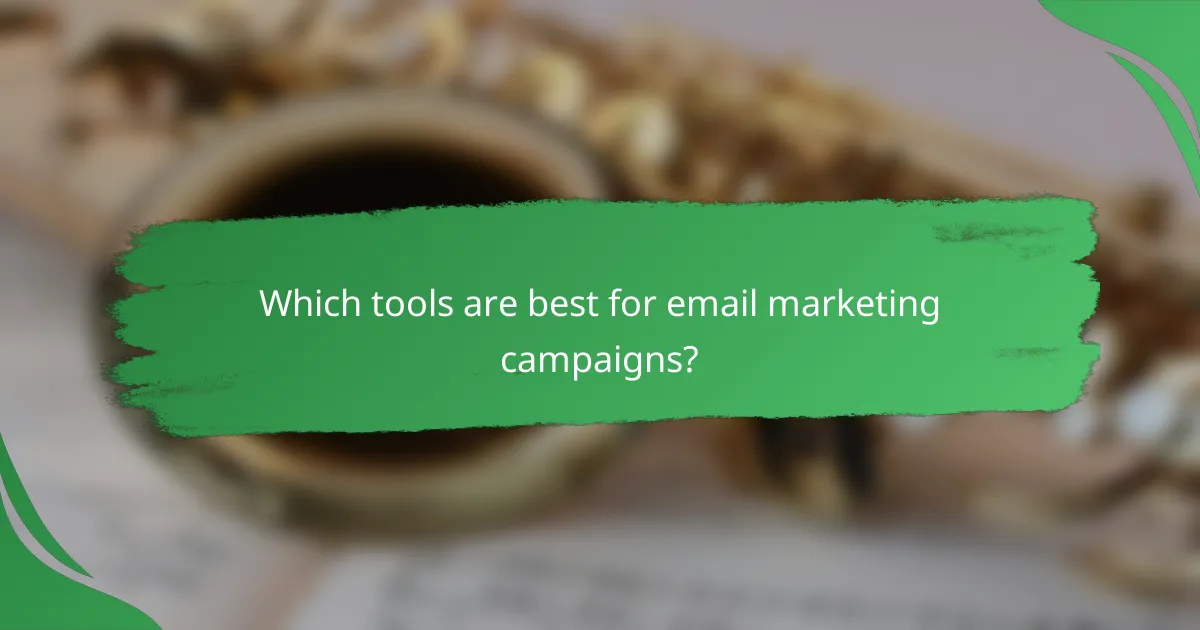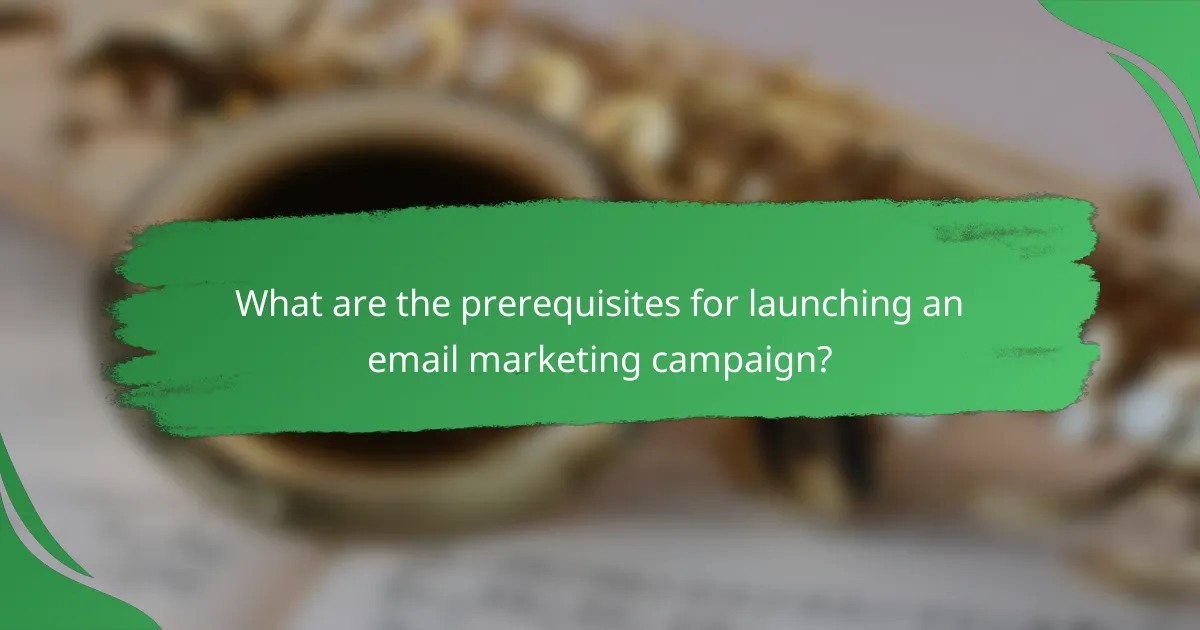Email marketing campaigns are essential for e-commerce success, emphasizing the importance of targeting the right audience with personalized content and automating processes for efficiency. By leveraging effective strategies and utilizing the right tools, businesses can enhance engagement, drive sales, and build lasting customer loyalty. To ensure these campaigns are successful, it’s crucial to measure performance through key metrics such as open rates, click-through rates, and conversion rates.

What are effective email marketing strategies for e-commerce?
Effective email marketing strategies for e-commerce focus on targeting the right audience with personalized content, automating processes, and continuously optimizing campaigns. These strategies help increase engagement, drive sales, and foster customer loyalty.
Segmentation and personalization
Segmentation involves dividing your email list into smaller groups based on specific criteria such as demographics, purchase history, or engagement levels. Personalization goes a step further by tailoring content to individual preferences, making emails more relevant and engaging.
To implement segmentation, consider factors like customer behavior and preferences. For example, you might create segments for first-time buyers, repeat customers, and inactive subscribers. Personalizing emails with the recipient’s name or recommending products based on past purchases can significantly boost open and conversion rates.
Automated campaigns
Automated campaigns streamline your email marketing efforts by sending targeted messages based on specific triggers, such as cart abandonment or customer birthdays. This approach saves time and ensures timely communication with customers.
Common automated campaigns include welcome emails, follow-ups after a purchase, and re-engagement emails for inactive customers. Setting up these workflows can lead to higher engagement rates and improved customer retention without requiring constant manual effort.
A/B testing
A/B testing, or split testing, involves comparing two versions of an email to determine which one performs better. This method helps identify the most effective subject lines, content, and layouts for your audience.
When conducting A/B tests, focus on one variable at a time, such as the call-to-action button color or the email layout. Analyze the results to make data-driven decisions that enhance future campaigns. Aim for a sample size that gives statistically significant results to ensure reliability.
Engaging subject lines
Engaging subject lines are crucial for improving open rates and capturing the recipient’s attention. A compelling subject line should be concise, clear, and relevant to the email content.
Consider using action-oriented language, posing questions, or including personalization elements. For instance, “John, don’t miss out on 20% off your next purchase!” can create a sense of urgency and relevance. Test different styles to find what resonates best with your audience.
Mobile optimization
With a significant portion of emails opened on mobile devices, optimizing your emails for mobile viewing is essential. This includes ensuring that your emails are responsive and easy to read on smaller screens.
Use a single-column layout, larger fonts, and clear call-to-action buttons to enhance the mobile experience. Test your emails on various devices and email clients to ensure consistent performance and usability across platforms.

Which tools are best for email marketing campaigns?
Several tools stand out for their effectiveness in managing email marketing campaigns. The best options often depend on your specific needs, such as budget, audience size, and desired features.
Mailchimp
Mailchimp is a popular choice for its user-friendly interface and robust features. It offers a free tier for smaller lists, making it accessible for startups and small businesses. Key functionalities include customizable templates, automation options, and detailed analytics.
When using Mailchimp, consider its pricing structure as your list grows; costs can increase significantly with larger audiences. It’s advisable to regularly review your plan to ensure it aligns with your marketing goals.
Constant Contact
Constant Contact is known for its excellent customer support and extensive training resources. It provides a wide range of templates and tools for list segmentation, making it easier to target specific audiences effectively.
One of the standout features is its event marketing capabilities, which can be beneficial for businesses that host events. However, be aware that while it offers a 60-day free trial, the pricing can be higher compared to other tools once the trial ends.
Sendinblue
Sendinblue combines email marketing with SMS campaigns, making it a versatile option for reaching customers through multiple channels. Its pricing is based on the number of emails sent rather than the size of your contact list, which can be cost-effective for high-volume senders.
Additionally, Sendinblue includes automation features and a CRM tool, allowing for more integrated marketing efforts. However, users should note that its email design capabilities may not be as advanced as some competitors.
HubSpot
HubSpot is a comprehensive marketing platform that includes email marketing as part of its suite of tools. It excels in providing advanced analytics and integration with other marketing efforts, making it suitable for larger organizations.
While HubSpot offers a free tier, its more advanced features come at a premium. Businesses should evaluate whether the investment aligns with their overall marketing strategy, especially if they require extensive automation and reporting capabilities.

How to measure the success of email marketing campaigns?
Measuring the success of email marketing campaigns involves analyzing various key performance indicators (KPIs) that reflect engagement and effectiveness. Focus on metrics such as open rates, click-through rates, conversion rates, and return on investment to gain insights into your campaign’s performance.
Open rates
Open rates indicate the percentage of recipients who opened your email, providing insight into the effectiveness of your subject line and sender reputation. A typical open rate can range from 15% to 25%, depending on the industry.
To improve open rates, consider segmenting your audience and personalizing subject lines. Avoid spammy phrases and ensure your emails are mobile-friendly, as many users check emails on their phones.
Click-through rates
Click-through rates (CTR) measure the percentage of recipients who clicked on one or more links within your email. A good CTR generally falls between 2% and 5%, but this can vary by industry and audience.
To enhance CTR, include clear calls to action (CTAs) and ensure your content is engaging and relevant. A/B testing different layouts and CTAs can help identify what resonates best with your audience.
Conversion rates
Conversion rates reflect the percentage of email recipients who completed a desired action, such as making a purchase or signing up for a webinar. Typical conversion rates for email campaigns hover around 1% to 5%.
To boost conversion rates, ensure your landing pages are optimized for the actions you want users to take. Use compelling offers and provide a seamless user experience from the email to the landing page.
Return on investment
Return on investment (ROI) measures the revenue generated from your email campaigns relative to the costs incurred. A positive ROI indicates that your campaigns are financially effective, with many businesses aiming for a return of at least 400%.
To calculate ROI, subtract your total campaign costs from the revenue generated, then divide by the total costs and multiply by 100. Regularly reviewing and optimizing your campaigns can help maximize ROI over time.

What are the prerequisites for launching an email marketing campaign?
Before launching an email marketing campaign, it’s essential to have a clear strategy, a targeted email list, and defined goals. These prerequisites ensure that your campaign is effective and reaches the right audience.
Building a quality email list
Creating a quality email list is crucial for the success of your campaign. Start by collecting emails through sign-up forms on your website, social media, and during events. Ensure that you have permission to contact these individuals to comply with regulations like GDPR.
Focus on attracting subscribers who are genuinely interested in your offerings. Consider using incentives such as discounts or exclusive content to encourage sign-ups. Regularly clean your list by removing inactive subscribers to maintain engagement rates.
Defining campaign goals
Clearly defined campaign goals guide your email marketing efforts and help measure success. Common goals include increasing sales, boosting website traffic, or enhancing brand awareness. Establish specific, measurable objectives to track progress effectively.
For instance, aim for a specific percentage increase in sales over a defined period or set a target for click-through rates. Regularly review these goals and adjust your strategies based on performance metrics to optimize future campaigns.


